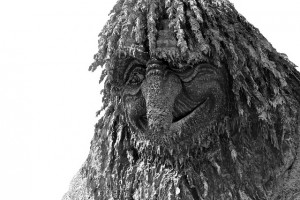7 Facts about Trolls Posted by Bjørn A. Bojesen on Feb 25, 2016 in Nature, Traditions

A real Norwegian troll from the Hunderfossen amusement park in the Lillehammer area. (Photo courtesy of Jan Hammershaug at Flickr, CC License.)
Turister (tourists) never seem to tire of troll (trolls), so I hope you won’t mind yet another look at Norge’s most popular inhabitants. 🙂 As I recently had the fun task of doing some troll research, I thought I’d share a few fakta (facts) with you:
1. The first troll in history was Norwegian and female. She appeared in a norsk skog (Norwegian wood) in the 800’s, challenging the Viking poet Bragi to a gammeldags (old-world) kind of rap battle. Bragi made the best dikt (poem), and was allowed to escape without the troll killing him…
2. Originally trolls existed only in Skandinavia. England had goblins and many other creatures, but no trolls. The Norwegian word troll entered English only after the folkeeventyr (folk or fairy stories) by Asbjørnen og Moe had been translated (19th century). The 3 Billy Goats Gruff (De tre bukkene Bruse), for example, was a huge hit, and the Norwegian trolls went viral in Britain and the US! 🙂
3. I middelalderen (in the Middle Ages), laws from Bergen and Oslo prohibited the ”awakening of trolls”. If you went ut i naturen (into Nature) to ”wake up” a troll, everybody knew you were the enemy of kirken (the Church). With such skills, at least, you could not be a normal menneske (human being).
4. In the movie Trolljegeren (the Troll Hunter) you can see the classical ”troll look”: stor, stygg, lang nese, hale (big, ugly, long nose, tail). This design was made popular by Norwegian painters Theodor Kittelsen and Erik Werenskiold.
5. Norwegian trolls sometimes have more than 1 hode (head). The number of heads can often be divided by three – 3, 6, 9, 12 hoder… In the story ”Mumle gåsegg” (”Mumble Goose-egg”), however, there’s a troll with 7 heads.
6. If you’re attacked by a troll, the best way å overleve (to survive) is to keep talking! Trolls are not too clever. In the story ”Askeladden som kappåt med trollet” (Askeladden who had an eating contest with the troll), the boy Askeladden convinces the troll that stabbing yourself in magen (the belly) is a great way to renew your appetite…
7. Troll er nattaktive (trolls are active at night). Keep entertaining the troll till soloppgang (sunrise), and it will turn to stein (stone)!

Build vocabulary, practice pronunciation, and more with Transparent Language Online. Available anytime, anywhere, on any device.
About the Author: Bjørn A. Bojesen
I was born in Denmark, but spent large parts of my childhood and study years in Norway. I later returned to Denmark, where I finished my MA in Scandinavian Studies. Having relatives in Sweden as well, I feel very Scandinavian! I enjoy reading and travelling, and sharing stories with you! You’re always welcome to share your thoughts with me and the other readers.




Comments:
Melissa:
Here’s a fun book by Ingri and Edgar D’Aulaire:
http://www.amazon.com/DAulaires-Trolls-Review-Childrens-Collection/dp/1590172175/ref=sr_1_7?s=books&ie=UTF8&qid=1456414028&sr=1-7&keywords=trolls
It was originally issued in 1972 but is available again. I’ve always loved their artwork. Ingri grew up in Norway and she and Edgar created several books about Norwegian children, including “Children of the Northern Lights,” a tale about the Sami.
Bjørn A. Bojesen:
@Melissa @Melissa
Thanks for the book tip! 🙂 I really like the illustrations (as shown on Amazon).
Steve Eriksen:
Enjoy your posts –
Nyt dine innlegg –
Sally:
Tusen takk for all the information on trolls! I have watched Trolljegeren a couple of times. I think I have watched all the Norwegian movies on Netflix. Sadly, there aren’t enough of them. I would really like to watch the knitting marathon in the winter but the Norwegian television system won’t let me, too bad!
Julie Watts:
I enjoyed your post on trolls. I am very interested in the origin of trolls. I have read on a Viking Re-enactor website that there are no mention of trolls in the Viking sagas. The dwarfs mentioned in the sagas seem to be similar to what we think of as trolls and were not necessarily all short in stature. So I will check out the saga you mentioned. Tusen Takk!
Bjørn A. Bojesen:
@Julie Watts @Julie Watts
I’m happy you liked the post. 🙂 I don’t know if there is an overlap between dwarves and trolls in the sagas. I would be interested in hearing what you discover!